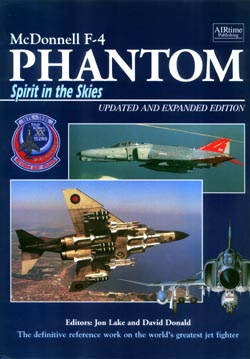 McDonnell F-4 Phantom: Spirit in the Skies McDonnell F-4 Phantom: Spirit in the Skies
Editors: Jon Lake and David Donald
AIRtime Publishing, 2002
ISBN 1-880588-31-5
272 pages, Hardbound
$39.95 from Specialty Press This latest title from AIRtime states that it is "the definitive reference work on the world's greatest jet fighter" and while some may dispute that the Phantom is the world's greatest jet fighter, this book does provide an excellent reference on the F-4. The format of the book follows that seen in AIRtime's other publications such as World Air Power Journal, International Air Power Review, and Wings of Fame. Four main chapters cover the development, combat introduction, world adoption, and the final decline and removal from service. After these initial pages, the book begins describing the Phantom operators, starting with the current countries. These include Egypt, Germany, Greece, Iran, Israel, Japan, South Korea, Spain, Turkey, and the United States. This section provides information on what units fly the Phantom currently, as well as a general overview of the air forces. Each country's section also includes several photos in color, providing some interesting looks at the lesser known operators like Iran. Next up is a very detailed section on Phantom weaponry. This section comes with lots of photos as well as detailed drawings of the individual weapons. Several tables provide information on the weapons, such as warhead and weight. Both U.S. and foreign weaponry are covered, providing a very complete reference on weaponry. Sections include general-purpose bombs, penetration bombs, fuel-air explosives, laser designation systems, paveway laser-guided bombs, electro-optical and imaging infrared bombs, fire bombs, cluster bombs, underwater mines, rockets, nuclear bombs, training weapons, ECM pods, infrared countermeasures, guns, air-to-air missiles, and air-to-surface missiles. Basically, if it was hung underneath a Phantom, you'll find it in here. A variant overview comes next, and this section does a great job of explaining the various differences between the many marks of the Phantom. The first part in this section details the construction of the Phantom, broken down into sub-systems. Following this is a detailed type description, starting with the mockups and the YF4H-1 and continuing on to the Super Phantom/Kurnass 2000. Detailed drawings with callouts show the differences between the marks, while the text explains why these changes were made. Finally, photos throughout the section provide a glimpse of many of the different variants. Right after this section is one that covers the cockpit in a similar fashion, providing photos of the instrument panels and consoles, as well as providing first-person accounts of what it was like to fly the Phantom. The final section covers the Phantom users, broken down into squadron service. Every unit that flew the Phantom, in all twelve countries, are listed here, with much information presented. Serial number lists, prior ownership, dates, and operating bases are just some of the information presented. In addition to this, photos illustrate nearly all of the squadrons listed. In short, this is an excellent reference on the Phantom and any Phantom Phanatic should pick one up, if for no other reason than to have a single-source reference for their Phantom collection. This book is available from Specialty Press for $34.95. There is a $4.95 shipping and handling charge on every order. Check out their website for other great titles. | 







|
 McDonnell F-4 Phantom: Spirit in the Skies
McDonnell F-4 Phantom: Spirit in the Skies 






